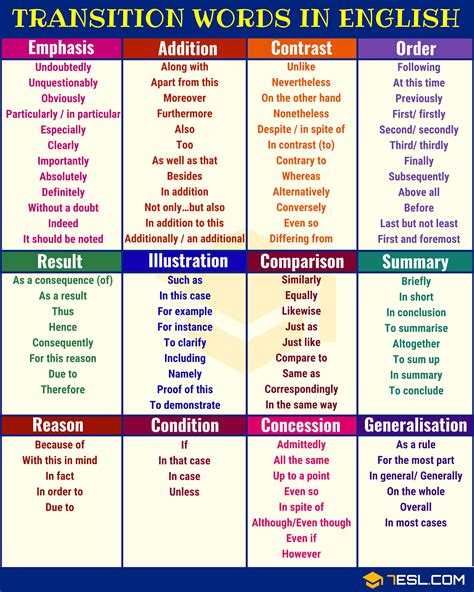Transition words are the glue that holds your writing together. They help your readers follow your train of thought, understand the relationships between your ideas, and engage with your content. In short, they make a big difference in the readability and effectiveness of your writing.

Types of Transition Words
There are many different types of transition words, each serving a specific purpose. Here’s a quick overview:
- Addition: Add information, such as “also,” “besides,” “in addition,” “moreover”
- Contrast: Express opposing ideas, such as “but,” “however,” “on the contrary,” “nevertheless”
- Comparison: Draw parallels between ideas, such as “similarly,” “likewise,” “in the same way,” “comparatively”
- Chronological Order: Indicate time sequence, such as “first,” “next,” “afterward,” “finally”
- Cause and Effect: Explain relationships between events, such as “because,” “consequently,” “therefore,” “as a result”
Using Transition Words Effectively
To use transition words effectively, consider the following tips:
- Variety is Key: Use a wide range of transition words to avoid monotony.
- Placement Matters: Place transition words at the beginning or end of sentences for maximum impact.
- Avoid Redundancy: Avoid using multiple transition words in a row.
- Use Vivid Language: Opt for active transition words over passive ones, such as “instead of” instead of “in place of.”
Transition Words in Action
Let’s see how transition words can improve a piece of writing:
Before Transition Words:
The company faced many challenges. It needed to increase profits. It also needed to improve customer satisfaction.
After Transition Words:
The company faced many challenges. First, it needed to increase profits. Additionally, it needed to improve customer satisfaction.
The use of transition words provides a smoother flow, making it easier for readers to follow the author’s thought process.
Transition Words Table
For your convenience, here’s a table summarizing the types of transition words:
| Type | Examples |
|---|---|
| Addition | Also, besides, in addition, moreover |
| Contrast | But, however, on the contrary, nevertheless |
| Comparison | Similarly, likewise, in the same way, comparatively |
| Chronological Order | First, next, afterward, finally |
| Cause and Effect | Because, consequently, therefore, as a result |
Conclusion
Transition words are an essential element of effective writing. By understanding their different types and using them strategically, you can improve the clarity, coherence, and readability of your content. Remember, it’s not just about adding words; it’s about using the right words in the right places to guide your readers through your ideas effortlessly.
